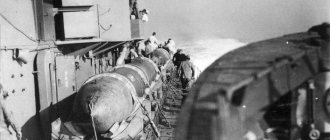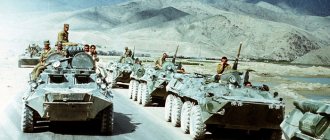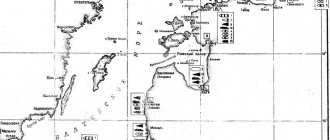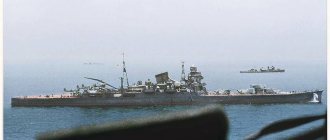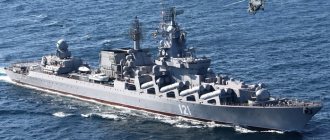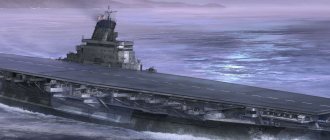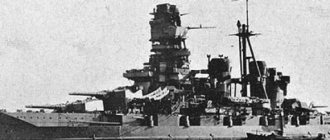Japanese Navy
The Japanese Navy has deep roots in history. The history of the Japanese navy itself is very rich. The first chronicles mentioning the Japanese fleet appeared at the beginning of the 10th century. Accordingly, we can talk about at least the 11th century history of the Japanese fleet. Throughout the Asian part of the Pacific basin, the fleet was of great importance long before the European discoverers. However, Asian culture and religion are more conservative. This can explain why China or Japan are not known throughout the world as discoverers or navigators, despite their capabilities at that time.
As I already wrote, the history of the Japanese fleet is very rich, so we will analyze the history of the Japanese fleet starting from the end of the nineteenth century, or more precisely from the Sino-Japanese War.
Sino-Japanese War 1894-1895
China and Japan have been each other's potential enemy number 1 since ancient times. Towards the very end of the nineteenth century, a war broke out between these two countries, where the Japanese Empire won complete victory. In almost a year, the Japanese fleet managed to neutralize the Chinese fleet and capture Manchuria. Moreover, China signed the Shimonoseki Pestilence Agreement, according to which it had to pay an indemnity in the amount of 360 million yen; transfer the Lyaudong Peninsula and the Pescadores Islands into Japanese hands.
Russian-Japanese War 1904-1905
Relations between the two empires began to deteriorate due to disagreements between the two countries over influence on China and Korea. The main aspect of disagreement was the desire of Imperial Russia to reduce its influence after the triumph of Japan in the Sino-Japanese War. In turn, Imperial Japan created an anti-Russian mood in the country, which in the future led to hostilities. To be more precise, negotiations regarding the division of territories of influence continued for more than a year in 1903-1904, but the countries were never able to reach a common compromise.
It is worth noting that Japan’s preparations for war with Russia began immediately after Russia supported China in 1895 and played a major role in pacifying the Japanese appetite only with monetary indemnity. A year later, Russia came to an agreement with China to lease the Liaudong Peninsula, where the main naval base of the Far East, Port Arthur, was opened. Thus, Imperial Japan adopted a declaration to renew the fleet for a possible future war with Russia.
After the experience gained in the war with China, Japan decided to update its fleet. The new warships were built to European standards and were in no way inferior to the European powers. Japan established its relations with European countries back in 1893, ordering two battleships (Yashima and Fuji) from Great Britain. Great Britain was number “1” in the world in terms of naval forces, so Japan decided to establish close ties with it.
Thanks to the huge indemnities received from China, Japan was able to update its fleet by 1903. The main supplier of ships was Great Britain, with secondary suppliers being Germany, the United States, Italy and France. Japan mainly used its national shipyards to repair and modernize its old ships and ships captured from China. Japan was still able to build two battleships (Niitaka and Tsushima) on national lines after completing the modernization and repair of its old ships.
In total, in almost one decade of fleet renewal, Japan spent about 250 million yen. Japan took the issue of the fleet very seriously, so the Admiralty and the country's authorities did not save and tried to build a modern fleet that meets all standards. Another aspect of costs was the purchase of ammunition, coal, etc. Japan also paid great attention to personnel training. For example, the most famous admiral of that time, Admiral Heihachiro Togo, is a graduate of the Royal Naval Academy (Great Britain). Japan spared no expense on exercises, shooting and practice of any nature.
As a result, Japan entered the war with:
- 6 units armadillos;
- 19 units cruisers (armored, armored and conventional);
- 23 fighters;
- 53 destroyers (conventional and squadron).
In turn, Russia, tired of constant wars (on which more money was spent than trophies received), was practically not ready for war. Outdated naval equipment and lack of ammunition were the main problems of Imperial Russia.
The naval battle Tsushima is the main naval battle between the two countries. Japanese Admiral Togo, using the “T” tactics, was able to win a landslide victory over Russian forces. Moreover, Tsushima is recorded as one of the three great naval battles.
Japanese Army Fleet during World War II
After successes in the wars against China and Russia, a symbolic victory in the First World War (Japan did not participate in direct hostilities), Imperial Japan continued to show an aggressive policy.
Before the start of World War II, the Japanese fleet was the third most powerful in the world, behind the fleets of Great Britain and the United States. However, the country's infrastructure itself was much inferior to the first two.
The main focus of the Japanese fleet was on aircraft-carrying ships. Thus, Japan wanted to gain an upper hand over its Pacific neighbor, the United States. While the European allies (Fascist Germany and Italy) were to conquer Europe, Africa, and most of Asia, Japan was to fight China and the USSR in Asia and put most of its force behind containing the United States. However, the main actions of Japan took place precisely with the latter.
The famous attack on the US Navy base at Pearl Harbor sparked war between Japan and the United States. However, the attack itself was not as successful as Japan describes it or as horrific as US authorities describe it. Japan wanted to inflate the effect of its attack, and the United States wanted to use this attack to embody the American spirit of the people as one, because the United States needed to start a war against Japan, which was on the other side of the Pacific Ocean.
At the start of the war, Japan had aircraft carriers, seaplane carriers, submarine aircraft carriers, battleships, heavy and light cruisers, submarines, destroyers, minesweepers, destroyers and many other auxiliary ships. However, the main force was the aircraft carriers. The aspect of underwater aircraft carriers is worth noting. According to some reports, with the help of these ships, Japan was able to organize the only continental attack on the United States during the Second World War.
As Japanese naval commander Yasoroku Yamamota predicted, the Imperial Japanese fleet had no chance of winning this war. The main reason for this was the technological and economic advantage of the United States. Throughout the war, the US Navy actively built and replenished the ranks of its fleet, while in Japan, the country's military and raw material reserves decreased with every day of the war.
The Japanese fleet was still able to achieve several striking victories - a naval battle off Savo Island, in the Java Sea, and an aircraft carrier raid in the Indian Ocean. Subsequently, luck went on the side of the US Navy. The American fleet dealt a serious blow to the Japanese fleet in the Coral Sea, and then came the turning point for the Japanese - the naval battle of Midway. At Midway, the Japanese fleet was almost completely destroyed. After the Battle of Midway, the Imperial Japanese fleet was not strong enough to fight on the high seas and carried out only air strikes (mostly kamikazes) against its enemy.
They talked a little - they did a lot
Victory in the Russo-Japanese War gave the Japanese the title of a major naval power. However, Japan's battlefleet consisted 100% of battleships built abroad. Exactly half of them (6 out of 12) were deprived of warranty service and required serious investments to bring them into combat-ready condition. The reason for this was known circumstances. After the fall of Port Arthur and the salvoes of Tsushima, the Japanese captured, raised from the bottom and restored 17 warships of the Russian Imperial Navy , among which were the Varyag and six battleships. Eight years later, the captured ships were put under fire from the 356-mm guns of the Kongo-class battlecruisers. The targets sank to the bottom. And the Japanese themselves tried not to mention the fact that they became the owners of the largest warships in the world and, probably, the strongest at that time. The lead Congo was laid down at the Vickers shipyard on the eve of the First World War. And became the last Japanese ship built abroad. Each subsequent type acquired more and more independence. Until it was Nagato's turn.
In 1920, the Japanese introduced a monstrous ship that was at least a decade ahead of its peers. The main caliber is 16 inches, protected according to the best standards of the era and the stated speed is 23 knots. No one had such a combination of parameters! The real characteristics of the Nagato became known only in 1945. When the American military boarded the captured battleship and made a lot of interesting discoveries. The power plants of the US “standard battleships” developed a power of about 30,000 hp. s., providing the squadrons with a single maximum speed of 21 knots. As decades passed, it became clear that the chosen standard was unacceptably small to counter Japanese battleships. In the Nagato engine rooms, 4 turbines with a total capacity of 80,000 hp were found. s., and the real speed of the Japanese exceeded 26 knots.
Current state of the fleet
After a humiliating defeat in World War II, Japan was prohibited from having an Armed Forces. However, in 1952, the Japanese authorities found a way to circumvent this ban by creating the Japanese Self-Defense Forces.
Everyone is well aware of the level of Japanese technology and infrastructure. Accordingly, Japan builds almost all its military equipment at national factories. However, it is worth noting that this situation was not always like this. After the start of the Cold War, US authorities actively supported Japan. Thus, the country that dropped nuclear bombs on Hiroshima and Nagasaki became Japan's number 1 friend. Nowadays, the United States also supports Japan against a new world player - Japan. Therefore, the fleet of the Japanese Self-Defense Forces does not consist entirely of national equipment. Nowadays, Japan mainly purchases aircraft equipment and some licenses from the United States and NATO countries to build ships for its fleet.
The first representative of the class of fast battleships
Faster than all Americans. Faster than the Nelsons built in the late 1920s. Even faster than the Queen Elizabeth , the fast wing of the British fleet. Only rare battle cruisers could compete with the Japanese supermachine. Unlike which, Nagato had no compromises in terms of weapons and protection. Thanks to twice the power density, Japanese battleships spent less time restoring speed after maneuvers. They could put the "stick over the T" of any formation of "standard battleships" or escape from superior forces, only to attack again in an unexpected place. Dictating your initiative and the rules of battle. Another surprise of "Nagato" had to do with its defense scheme. In theory, it repeated the American concept
"all or nothing".
As it turned out later, the Japanese ship had protected ends. The story of “Nagato” is a complete failure of Western intelligence, which threatened with serious consequences in battles. A reminder of the principles that have always guided the Japanese Armed Forces. The last joke was related to the 41 cm/45 guns, which in the spring of 1922 were urgently redesignated as 40 cm/45. Under the terms of the Washington Agreement, the main caliber of battleships was not to exceed 16 inches (406 mm). Pure little things, a few extra millimeters. But the little lie turned into a big scam. The next time, under the designation 40 cm/45, 460 mm guns were created for the battleships Yamato. With the veil of secrecy around Yamato, the samurai clearly overdid it. At some point, you had to show your cards to make the most of the situation. The appearance of such ships on the theater of operations could force the enemy to take precautions and slow down the pace of the offensive. Having spent inadequate efforts to neutralize the threat, similar to the Tirpitz story. The Yankees themselves would rush to build super-battleships with 500 mm artillery - to the detriment of other tasks. For a country that could afford the construction of Alaska, such a project would be just right. But the Japanese did not need scandalous fame. They remained composed and calm in anticipation of an artillery duel, where they would be able to surprise the enemy with their main caliber.
Japanese Navy vs Russian Navy
Many experts are trying to make a comparative analysis of the Japanese and Russian fleets. It is taken into account that Japan has about a hundred ships and is in second place in the number of destroyers. In particular, there are two missile destroyers (10 thousand tons of displacement) and a helicopter carrier Izuto (27 thousand tons). Japan, whose Navy is peacekeeping-oriented, has a specialization in anti-submarine and air defense. The total displacement of the Japanese fleet is 405.8 thousand tons.
The Russian fleet, with a displacement of 927,120 tons, is armed with ships left over from the days of the Soviet Union. The newest destroyer is twenty years old, the oldest is fifty years old, but all submarines have been modernized and equipped with modern military equipment. Unfortunately, more than half of the ship's personnel are subject to modernization and replacement.
Escort force structure
The escort force, under the command of a vice admiral, is led by headquarters located at the Yokosuka naval base.
Subordinate to him are:
- flagship;
- four flotillas with destroyers located at the bases of Yokosuke, Sasebo, Kure and Maizuru;
- six separate divisions of destroyers or frigates;
- units with landing ships;
- supply transports;
- ships providing combat training;
- study group.
The flotillas are headed by rear admirals, who are subordinate to the corresponding headquarters and 4 destroyers, united in divisions, divided into two types.
The first type division consists of:
- destroyer-helicopter carrier;
- destroyer with guided weapons;
- two conventional destroyers.
The second type includes three ordinary destroyers and one with a guided missile charge.
Individual divisions have from two to five vessels. The location of the ships belonging to the frigate (destroyer) unit is one of the naval bases.
Vessels included in the supply transport division are allowed to be stationed at various bases.
Separate groups of landing ships are equipped with Osumi helicopter docks, which are located at the Kure base. In addition, each division includes six air-cushioned boats designed for landing.
The training group includes a headquarters located in Yokosuka and five training detachments distributed at various bases.
Has no analogues?
It’s hard to believe that none of the Japanese leaders, with or without shoulder straps, deigned to show off in front of the cameras against the backdrop of such “toys.” And there was something to see. Thus, based on the totality of available information, the hulls of Japanese submarines are made of steel with a yield strength of 1100 MPa. The use of such materials in shipbuilding is considered problematic (on the verge of impossible), due to unsatisfactory welding qualities. However, Kawasaki and Mitsubishi Heavy Industries seem to have discovered the secret long ago and have the necessary technology. The maximum diving depth for the Soryu and Taigei submarines under such conditions can reach 900 m. The world's deepest warships. Otherwise (while maintaining the immersion depth at the previous values), the use of high-strength steel NS110 means a significant reduction in the weight of the hull. The allocated reserves are spent on increasing other unknown characteristics. How many people know that Japan is mass-producing submarines with lithium-ion batteries as a single source of energy for underwater propulsion?
Extremely expensive underwater Teslas, which have no equal among other diesel-electric submarine projects. The first of these submarines (Ouryu) modestly entered service last year. And everyone thought it was a bold experiment. But now there are already three such units. The most recent one, the lead nuclear-powered submarine of the next generation, Taigei, was launched in October 2022. The launching of Japanese warships always had a surprise factor. The usual practice is the absence of official names until the moment of entry into service. In contrast to domestic traditions, where the laying of one bottom section is accompanied by loud fanfare and promises that the ship will enter service by the twentieth year. One of the last surprises was “Kumano”. The first of the new type 30FFM frigates, launched in November 2022.
It is noteworthy that “Kumano” is the second representative of the series. The lead unnamed frigate, known in the west as FFM-1, did not appear on time for an unknown reason. An indelible shame for Japanese shipbuilders - a whole year has passed since its laying, and it still has not been launched! The declared displacement of the Kumano is 5,500 tons. With its appearance, it became clear what the appearance of the Japanese Navy would be in the second quarter of the 21st century. Having built 28 destroyers using outdated technologies of the late 90s and early 2000s, the Japanese switched to new standards. The 30FFM project uses a different hull and superstructure architecture. Automation and augmented reality (AR) technologies in ship control systems have led to a further reduction in crew size to 90 people. It is stated that over the next ten years, 22 such compact frigates with advanced capabilities will be built. The 30FFM project will include several sub-series.
Tasks of the newly created fleet
Created as part of the Self-Defense Forces, the Japanese Navy was intended to:
- conduct combat operations with enemy naval and air groups to gain dominant influence in the sea and ocean waters off the coast of Japan;
- block strait zones in the Sea of Okhotsk, East China and Japan;
- conduct amphibious landing operations and provide support to ground units in the coastal area;
- protect sea communications, defend naval bases, bases, ports and coasts.
In times of peace, Japanese Navy ships guard national territorial waters, maintain a favorable operational regime in a thousand-mile ocean zone, and perform patrol duty, together with the Maritime Security Administration.
